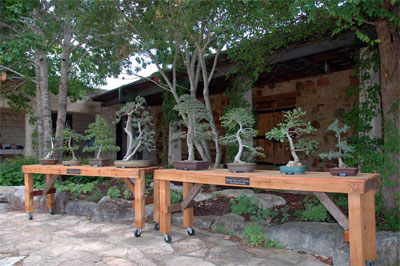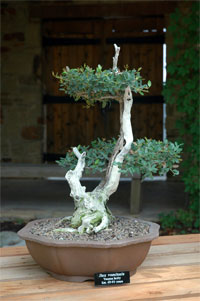Wild About Texas – July, 2008

Bonsai specimens created with native plants, on exhibit in the Lady Bird Johnson Wildflower Center courtyard. Photo by Joe Marcus.

Cedar elm (Ulmus crassifolia). Photos by Joe Marcus.
Bonsai with Native Plants
Native plant bonsai?? Why yes! Why not?
A captivating marriage of Texas native plants and ancient traditions of the Far East is on display in the Courtyard at the Lady Bird Johnson Wildflower Center now through August 31, courtesy of the Austin Bonsai Society (ABS). Thought to have originated in China during the Han Dynasty, around 200 B.C., and later adapted by the Japanese, bonsai (properly pronounced “bone’s-eye”) has become popular worldwide, even in Texas!
Bonsai, translated from Japanese, meaning tree in a tray, is the art of miniaturizing and styling woody plants such as trees, shrubs, and vines into forms that are inspired by or resemble their full-sized counterparts in nature. The result is not always a literal interpretation, and there are various bonsai forms ranging from the minimalist literati (or bunjin) to deshojo (roots over rocks) to kengai (cascades). The possibilities are truly intriguing.
Using specimens grown in pots that complement their form and style, bonsai takes regular plants, including natives, and employs the horticultural techniques of bud pinching, root pruning, trimming, fertilizing, and prudent watering to create living works of art. Seasonal changes offer dynamic interest as plants (depending on species) bud and leaf out in spring, bloom and fruit in summer, change color in fall and drop leaves for winter.
A few Texas species suitable for bonsai include:
acacia
Acacia species
Texas persimmon
Diospyros texana
Texas ebony
Ebenopsis ebano
Texas kidneywood
Eysenhardtia texana
yaupon holly
Ilex vomitoria
ashe juniper
Juniperus ashei
Barbados cherry
Malpighia glabra
bald cypress
Taxodium distichum
cedar elm
Ulmus crassifolia
mustang grape
Vitis mustangensis

Yaupon holly (Ilex vomitoria). Photo by Joe Marcus.
As stated on the ABS website, “Bonsai is a blending of artistic ability with horticultural expertise. No two people will design exactly the same tree in the same sense that no two artists will paint exactly the same picture.”
Bonsai are not difficult to grow, although they do need daily care, and the results are very rewarding. The Wildflower Center, in conjunction with UT Informal Classes, will offer a workshop, “Bonsai with Native Plants,” as part of its Go Native U program on Saturday, August 30. See the website for more information: www.wildflower.org/gonativeu/
Special thanks to the members of the Austin Bonsai Society for offering their specimens on loan and for providing educational and technical assistance for this exhibit. Their website is: www.main.org/bonsai/
For more information about Texas native plants, visit the Wildflower Center’s website at: www.wildflower.org.
About the author: Andrea DeLong-Amaya is the director of horticulture at the Lady Bird Johnson Wildflower Center in Austin.

